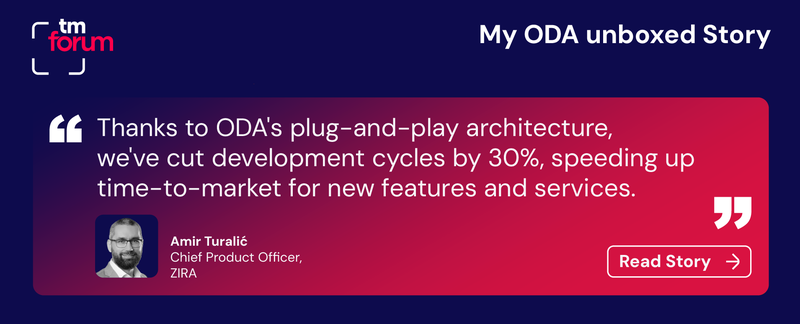ODA
Today, as the telecom landscape evolves from static connectivity to dynamic digital ecosystems, the pressure on operators to rethink their business models has never been greater.

ODA Unboxed: How ZIRA’s modular BSS suite delivers on the promise of Open Digital Architecture

With three decades of experience delivering mission-critical solutions to telecom operators worldwide, ZIRA has built a reputation for turning complex industry challenges into agile, future-ready systems. Today, as the telecom landscape evolves from static connectivity to dynamic digital ecosystems, the pressure on operators to rethink their business models has never been greater. Legacy systems, siloed processes, and rigid architectures are simply no match for the demands of real-time engagement, partner-centric business models, or the rapidly expanding universe of services that stretch far beyond traditional telecom.
Recently, ZIRA Group achieved Ready for ODA status for its BSS product portfolio, showcasing the benefits of adopting Open Digital Architecture (ODA). At the heart of this achievement is ZIRA’s Lead-to-Cash suite, a powerful, fully pre-integrated, modular set of business support systems designed not only to meet the needs of today’s CSPs but to grow alongside them.
We spoke with ZIRA’s Chief Product Officer, Amir Turalić, to understand how being accredited with Ready for ODA status has benefited the organization and its customers.
ZIRA’s modular Lead-to-Cash BSS suite has for years adopted standards set by TM Forum. We were early adopters of ODA: signing the Manifesto and actively supporting its development within the ODA community.
The suite supports modern telecom operators across key functions:
Designed for cloud-native deployment and Open API conformance, the suite delivers on the long-promised agility and composability that CSPs require, without sacrificing operational integrity.
ZIRA has always focused deeply on wholesale and Business to Business (B2B) telco, areas often underserved by standardized frameworks. While retail domains have long benefited from innovation, B2B and wholesale models often lag behind.
ODA alignment allows ZIRA to bridge that gap, demonstrating to our customers that we are not only committed to standards but actively shaping them. For our customers, this translates to clear roadmaps, faster onboarding, easier procurement, and smoother migrations.
One of the key reasons we aligned with TM Forum’s ODA is the way it standardizes interoperability across complex, multi-vendor environments. By following the Open API conformance model, we've seen a real operational difference:
That speed makes a big difference when trying to scale or pivot quickly.
In terms of delivery, ODA has helped us reinforce the modular approach we already had in place. Because of the plug-and-play nature of its architecture, we’ve been able to cut development cycles by about 30% on average. That directly affects how fast we can bring new features or services to market. And when you're working with CSPs who expect speed and flexibility, that can make or break a launch. In fact, some of our customers have seen time-to-revenue for new offerings improve by a factor of nearly 50%.
It has also been interesting to understand how this level of alignment affects things beyond technology, particularly in procurement. Having ODA compliance in place tends to reduce the amount of time procurement teams spend evaluating a solution. In some cases, it has shortened those cycles by around 25% and made due diligence smoother by 40% or more. Buyers clearly recognize the structure and transparency ODA brings, which helps build trust early in the process.
ODA offers a blueprint for scalability and openness, and ZIRA sees it as a natural extension of its long-standing architectural principles.
Our alignment with ODA principles has contributed to clear improvements across several key areas. Below are a few examples where this impact has been most evident.
We’ve also seen commercial impact. Since our initial ODA accreditation and increased involvement in TM Forum activities, our lead pipeline has grown by approximately 30%. This suggests that aligning our architecture with ODA is not only helping us deliver more efficiently but also building trust and credibility in the market. Clients increasingly recognize ODA conformance as a signal of maturity and long-term sustainability, and that’s been reflected in both procurement processes and early-stage conversations.
Maintaining ODA as our reference architecture wasn’t about rewriting everything overnight but about reframing what we already had. As with all processes, there are challenges to be considered, and in our case, they included:
By unifying our legacy TM Forum alignment with ODA’s vocabulary, we strengthened our architecture in ways that directly benefit our customers and the industry: faster upgrades, smoother integrations, and a clear roadmap for next‑generation services.
ODA readiness is a continuous process. Since our last accreditation, ZIRA has doubled down on enablement:
By equipping each role with the right knowledge, we ensure that ODA isn’t just a tech layer, it’s embedded into our entire delivery DNA.
ZIRA sees ODA as a strategic foundation, not just a “tick-the-box” process. It’s how we ensure our architecture evolves alongside our customers’ ambitions. With every deployment, every integration, and every product iteration, we aim to make telecoms more composable, more open, and more agile than ever before.
As we move toward 2026, we’ll continue building with ODA not only as a reference architecture but as a mindset.
Find out more about Ready for ODA here.